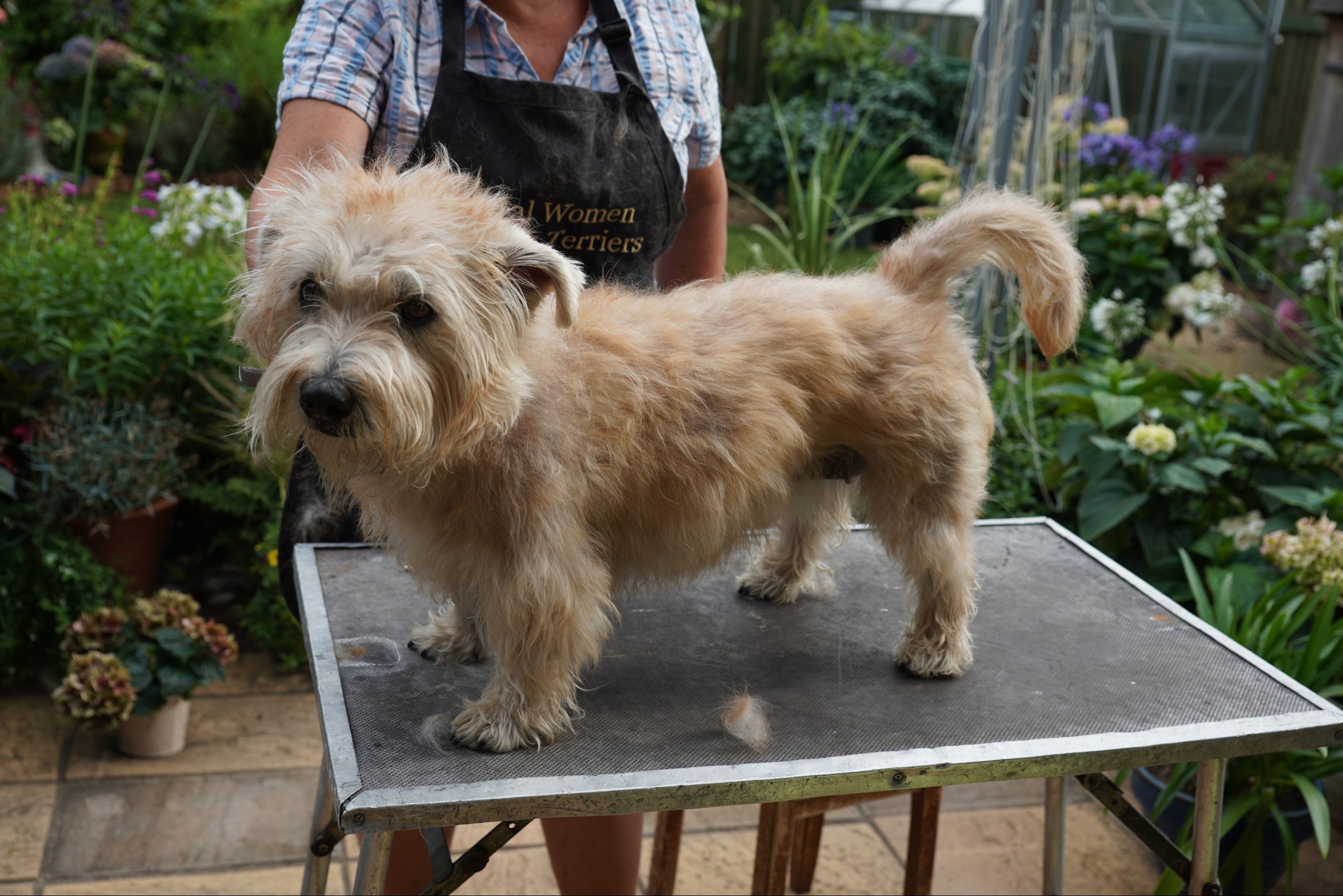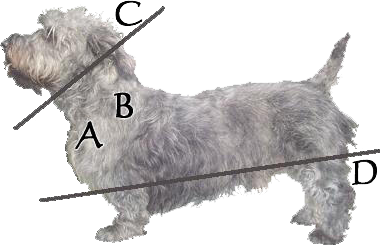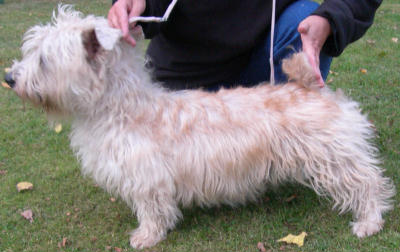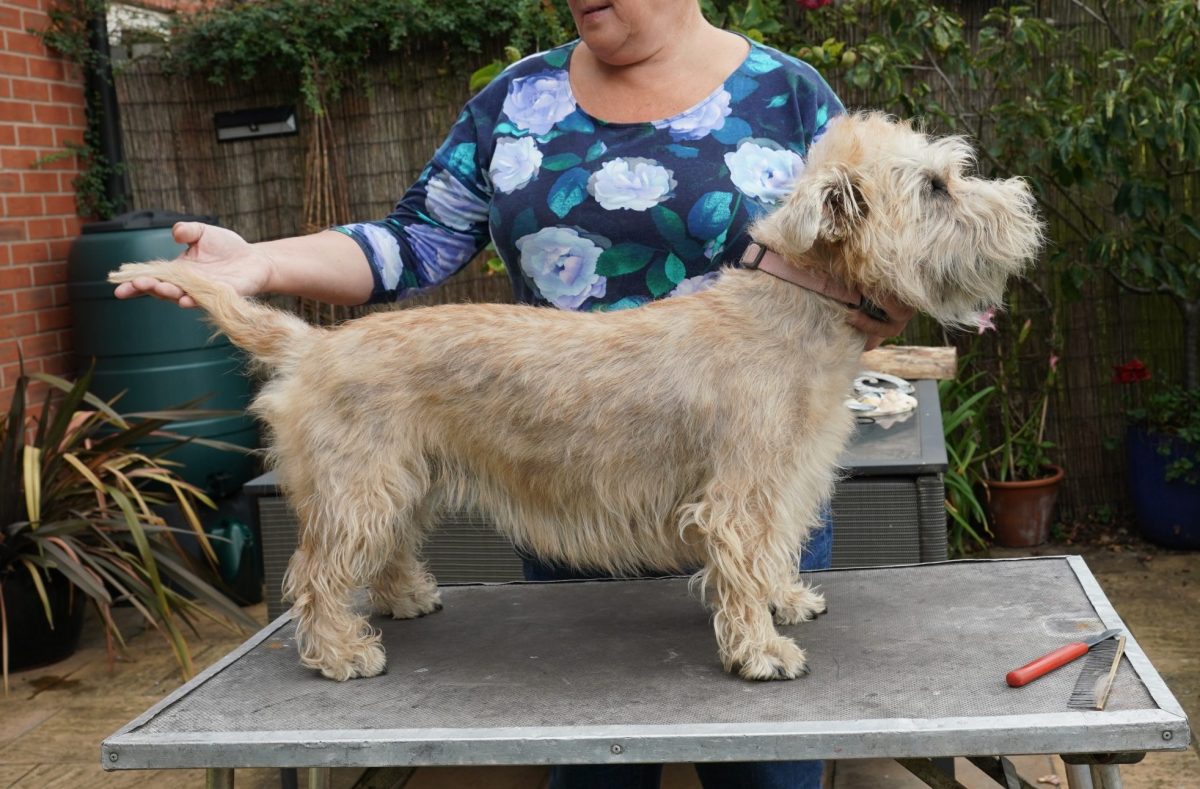Grooming your Glen

Glens do not shed their coat, but it still needs attention.
Their coat is a double coat consisting of a soft undercoat (which if not looked after will matt up) and a harsher, longer, outer coat.
Most owners have a preference to how their glen looks-whether its shabby chic or a more barbered version.
Day to Day Grooming Tips
Using a wide toothed comb run it through the dog’s coat from the head to the tail, combing in small sections and making sure the whole coat is thoroughly combed. Then a thorough comb in the opposite direction (tail to head) helps to open the coat further.. These two steps are repeated with a narrow toothed comb. This will stop the undercoat from matting and keep tangles and snarls under control.
If you don’t have a narrow toothed comb, weave an elastic band along the teeth of the comb until you have two layers of elastic, this will help take out the old undercoat.
If grooming is done gently it becomes an important bonding session between you and your dog.
Specific areas to check for knots and tangles are under the arms, in the groin area and on the underbelly. This is important because as the dog strides out, these knots and tangles will pull, making movement uncomfortable.
Things to look for when you are grooming
Ticks – If you exercise in the countryside, especially near sheep or other livestock, keep an eye out for ticks. They are usually found on the ear where the fur is thinner. There are products that you can buy at your local pet shop which will remove them or you can go to the vets. If you are removing them yourself make sure the tick is completely removed as the head sometimes breaks off and causes infections
Fleas – regular grooming will show if your dog has picked up fleas. Pet shops will provide sprays and shampoos to help you eradicate the problem.
General Care
Ears -The Glen usually has an hairy inner ear. Ear cleaners can be bought from vets or pet shops. Any long hairs growing out of the ear should be teased out after coating your fingers with talc. This should be done gently! Do not put any foreign object down into the ear canal. To finish, using your fingers and a cotton wool swab, clean gently around the inner ear with ear cleaner.
Eyes – because a Glen has hair around the eyes, there may be a slight discharge over-night. You will see it as a black blob. Take it between your fingers and gently tease it out.
Teeth – some dogs are prone to tartar. With a balanced diet the teeth should remain free of tartar but if this becomes a problem there are products that will keep the dog’s mouth free of scaling and smelling fresh.
Bottoms – If your Glen starts scraping its bottom along the floor it may mean its bottom is dirty or blocked. Carefully cut away the hair in this area making sure you angle the scissors away from the skin. If this bottom scraping continues the anal glands may need emptying. Consult the vet.
Claws and dew claws – usually claws wear down naturally, but if they have to be clipped just take the lighter coloured tip off . Special nail clippers can be bought from a pet shop. If your Glen still has its dew claws check them regularly as they may grow into the pad. Again they will need clipping if they become too long.
Pads – check between the toes and pad for clumps of mud, grit hair and grass seeds. Remove any detritus gently. Grass seeds can work their way under the skin and can travel. This can cause infections and so should be checked regularly.
This is all basic care, but so easily forgotten.
Grooming diagram and instructions
Please take these instructions and diagram to your groomer as they are unlikely ever to have worked on or seen a Glen.

Step by step
1. Start at the back of the head, the bump between the ears, and strip the hair off the entire length of the body. Don’t forget the tail and each side of the buttocks.
2. Strip the shoulders and chest (area A and B ). Leave the hair between the front legs.
3. Strip along the side of the body and top of the thigh ( line D ). Leaving the hair below the line to form “feathers”. If the dog is high on the leg leave a longer feather as it will help the dog appear lower to the ground. Also observe the front elbows. Glens have funny fronts but are not out at the elbow, too much hair left on here can make them appear to be so.
4. Tie a piece of wool under the dogs chin and behind its ears (line C ). All the hair to the front of this line is head hair. If you can’t manage to strip the hair directly behind the line, use trimming shears. These wispy bits, if left on, can make the difference between a good or bad neck particularly if your Glen is lacking in this area.
5. Head trimming depends on the dog; each Glen is different. As a generalisation, the hair is combed forward and (then the dog is encouraged to shake to make it lie satisfactorily. The Glen is still very much a “basic” dog so doesn’t need incredible flowing locks. Usually it helps a dog if the expression can be seen, so don’t let the forelock grow too long.
There are several tools on the market that can help keep your Glen tidy. One of the first is the “Mars Coat King” and the latest is the “Furminator”. Both claim to remove the old coat without cutting the hair. Another helpful product is the “Detangler spray” Which detangles and moistens the coat making it easier to groom.
Preparation for Showing

The Glen of Imaal is a hairy dog. Trimming is not difficult but does need doing whether the animal is a potential Best of Breed winner or the goalkeeper in the local park football team.
Preparation for showing is minimal. The Breed Standard says that the coat “may be tidied to present a neat outline”. You will, however, see Glens in the show ring that are more ‘tidied’ than others! Don’t worry, the hair grows to around three to four inches in length.
On average, a Glen needs stripping every nine to twelve months. Once stripped it is a case of waiting for the new coat to come in. Having said all this, it is not necessary to strip your Glen if you don’t want to. There is no real need unless you want to show them.
Puppy Coat
If the Glen is to be a pet it is not so essential to remove the puppy coat but a potential show dog needs it removing by twelve weeks approximately to allow the new coat through. When a puppy coat starts to “stand up ” gently pull it out with the finger and thumb.
On wheaten Glens it is easy to judge the correct time as the new deeper coloured adult coat can be seen but coloured Glens are more difficult as they seem to keep their puppy coats longer and it is also difficult to see the new colour.
Take all the hair from the neck, back and down the sides as far as the elbows on the body. Don’t upset the puppy by doing too much at once but you certainly need to start by twelve weeks if you hope to have the dog in the show ring.
Scissor round the ears and tail once a week – it won’t need it but it will get the dog used to the sound of scissors near the ear. Also start to pluck the inside of the ear. It is a lot easier to get a 10 lb. pup to co-operate than a 35lb adult.
Second Coat
This coat is easy to look after and the Glen takes little effort to groom as the leg and body feathers have not yet grown much and the head hair is not much longer than the body hair.
Continue to scissor the ears and tail regularly and, if possible, persuade the dog to lie on its side so you can comb under its legs. Its legs will probably not need much attention at this stage but having a dog that will roll over to be groomed will save hours when dealing with a fully coated mature animal. When this coat “blows” ( stands up and looks tatty ) the decision has to be made to what degree you are going to look after the adult coat. Here you either book a six month appointment at the local dog parlour, decide you will go for the “au natural ” look and attack it regularly with the kitchen scissors or buy a stripping knife and decide you will attempt to make an effort.
The really brave decide that they are going to totally hand strip and buy a giant box of plasters to protect their blisters.
Adult Coat
This is a profuse coat and unless taken care of, will quickly hide all the body lines of the dog. For the show ring you trim to show the animal’s best features. So start logically: put the dog on the table and look at it, so many forget this first basic step.
A Glen should have a nice neck, good body and well muscled hindquarters. These can’t be seen when covered with long hair so get rid of it! They should have broad skulls – not a narrow muzzle. Hair helps in this department so remove accordingly. Glens have excellent bone so take more off the legs of a dog with heavy bone than you do with lighter bone.
Important notes for stripping the coat
If you decide to strip your dog (hand stripping or stripping knife) you will need to keep moving over the whole of the body. If you try to stay in one spot you could end up with a bald patch – so keep moving.
Once you have finished stripping comb through the coat and finish by using the lava block for a nice even finish.
